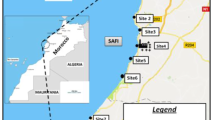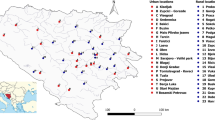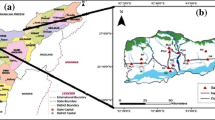Abstract
The city of Istanbul is constantly exposed to air pollution due to its high population, heavy traffic — sea and air transport — and urban industry. This study basically aims to determine the recent level of airborne heavy metals, using lichen biomonitoring method. The cosmopolitan foliose lichen Xanthoria parietina growing abundantly on trees was sampled from 16 urban green spaces in 8 districts on the Anatolian side of Istanbul. Multi-element analysis by ICP-MS was applied to measure the accumulation of 10 potentially toxic trace elements in lichen samples. Spatial distributions of element levels in the air in the sampling areas are shown by mapping. According to the analysis data, the sequence of element deposition levels in lichen samples was as follows; Al > Fe > Mn > Zn > Cr > Cu > Pb > V > Ni > As. Most of the measured atmospheric element amounts yielded results much higher than the reference material in all areas. It was detected that the highest pollution in terms of Al, Cu, Fe, Mn, and Ni elements was in Elmasburnu Nature Park area in Beykoz district, which is a touristic place by the sea. Changes in the city’s air quality over the years have been evaluated by comparing element levels in these locations in a previous biomonitoring study and some differences were found. The resulting data is valuable for periodic monitoring of toxic elements in the air, for determining causes of air pollution, and for taking precautions.






Similar content being viewed by others
Data availability
All the data generated or analyzed during this study are included in this published article.
References
Backor, M., & Loppi, S. (2009). Interactions of lichens with heavy metals. Biologia Plantarum, 53(2), 214–222. https://doi.org/10.1007/s10535-009-0042-y
Belivermiş, M., Kılıç, Ö., & Çotuk, Y. (2008). Heavy metal and radioactivity concentrations in soil and moss samples from Istanbul, Turkey. IUFS Journal of Biology, 67(1), 39–47.
Bozkurt, Z. (2017). Determination of airborne trace elements in an urban area using lichens as biomonitor. Environmental Monitoring and Assessment, 189, 573. https://doi.org/10.1007/s10661-017-6275-x
Brunialti, G., & Frati, L. (2007). Biomonitoring of nine elements by the lichen Xanthoria parietina in Adriatic Italy: A retrospective study over a 7-year time span. Science of the Total Environment, 387, 289–300. https://doi.org/10.1016/j.scitotenv.2007.06.033
Cislaghi, C., & Nimis, P. L. (1997). Lichens, air pollution and lung cancer. Nature, 387, 463–464. https://doi.org/10.1038/387463a0
Çobanoğlu, G. (2015). The use of lichens for biomonitoring of atmospheric pollution. Sigma Journal of Engineering and Natural Sciences, 33(2), 591–613.
Çobanoğlu, G. (2021). Geçmişten Bugüne İstanbul Liken Çalışmaları Üzerine Bir Derleme. Bağbahçe Bilim Dergisi, 8(1), 259–266.
Çobanoğlu Özyiğitoğlu, G. (2020). Use of lichens in biological monitoring of air quality. In V. Shukla & Dr. N. Kumar (Eds.), Environmental concerns and sustainable development - Volume 1: Air, water and energy resources (pp. 61–95). Springer Nature. https://doi.org/10.1007/978-981-13-5889-0_3
Conti, M. E., & Tudino, M. (2016). Lichens as biomonitors of heavy-metal pollution. In M. Guardia & S. Armenta (Eds.), Comprehensive analytical chemistry - Volume 73: The quality of air (1st ed, pp. 117–145). Elsevier. https://doi.org/10.1016/bs.coac.2016.02.005
Coşkun, M., Steinnes, E., Coşkun, M., & Çayır, A. (2009). Comparison of epigeic moss (Hypnum cupressiforme) and lichen (Cladonia rangiformis) as biomonitor species of atmospheric metal deposition. Bulletin of Environment Contamination and Toxicology, 82, 1–5. https://doi.org/10.1007/s00128-008-9491-9
Daimari, R., Bhuyan, P., Hussain, S., Navaka, S., Mazumder, M. A. J., & Hoque, R. R. (2020). Biomonitoring by epiphytic lichen species Pyxine cocoes (Sw.) Nyl.: Understanding characteristics of trace metal in ambient air of different land uses in Mid-Brahmaputra Valley. Environmental Monitoring and Assessment, 192, 37. https://doi.org/10.1007/s10661-019-8007-x
Doğrul-Demiray, A., Yolcubal, I., Akyol, N. H., & Çobanoğlu, G. (2012). Biomonitoring of airborne metals using the lichen Xanthoria parietina in Kocaeli Province, Turkey. Ecological Indicators, 18, 632–643. https://doi.org/10.1016/j.ecolind.2012.01.024
Dzubaj, A., Backor, M., Tomko, J., Peli, E., & Tuba, Z. (2008). Tolerance of the lichen Xanthoria parietina (L.) Th. Fr. to metal stress. Ecotoxicology and Environmental Safety, 70, 319–326. https://doi.org/10.1016/j.ecoenv.2007.04.002
Garty, J. (2001). Biomonitoring atmospheric heavy metals with lichens: Theory and application. CRC Critical Reviews in Plant Sciences, 20(4), 309–371. https://doi.org/10.1080/20013591099254
Garty, J., Levin, T., Cohen, Y., & Lehr, H. (2002). Biomonitoring air pollution with the desert lichen Ramalina maciformis. Physiologia Plantarum, 115, 267–275. https://doi.org/10.1034/j.1399-3054.2002.1150213.x
Hissler, C., Stille, P., Krein, A., Geagea, M. L., Perrone, T., Probst, J.-L., & Hoffmann, L. (2008). Identifying the origins of local atmospheric deposition in the steel industry basin of Luxembourg using the chemical and isotopic composition of the lichen Xanthoria parietina. Science of the Total Environment, 405, 338–344. https://doi.org/10.1016/j.scitotenv.2008.05.02
IMM Istanbul Metropolitan Municipality. (2019). Available from: www.ibb.gov.tr
İçel, Y., & Çobanoğlu, G. (2009). Biomonitoring of atmospheric heavy metal pollution using lichens and mosses in the City of Istanbul. Turkey. Fresenius Environmental Bulletin, 18(11), 2066–2071.
İncecik, S., & İm, U. (2013). Megaşehirlerde Hava Kalitesi ve İstanbul Örneği (Ambient air quality in megacities and the case of Istanbul). Hava Kirliliği Araştırmaları Dergisi, 2, 133–145.
Işık, V., & Yıldız, A. (2021). Xanthoria parietina (L.) Th. Fr. likeni kullanılarak yapılan biyoizleme (=biyomonitoring) çalışmaları. MTA Doğal Kaynaklar ve Ekonomi Bülteni, 31, 87–99.
Kalıpsız, A. (1981). İstatistik Yöntemleri. İstanbul Üniversitesi, Orman Fakültesi. Doyuran Matbaası.
Klapstein, S. J., Walker, A. K., Saunders, C. H., Cameron, R. P., Murimboh, J. D., & O’Driscoll, N. J. (2020). Spatial distribution of mercury and other potentially toxic elements using epiphytic lichens in Nova Scotia. Chemosphere, 241, 125064. https://doi.org/10.1016/j.chemosphere.2019.125064
Kousehlar, M., & Widom, W. (2020). Identifying the sources of air pollution in an urban-industrial setting by lichen biomonitoring - A multi-tracer approach. Applied Geochemistry, 121, 104695. https://doi.org/10.1016/j.apgeochem.2020.104695
Kurnaz, K., & Çobanoğlu, G. (2017). Biomonitoring of air quality in Istanbul Metropolitan Territory with epiphytic lichen Physcia adscendens (Fr.) H. Olivier. Fresenius Environmental Bulletin, 26(12), 7296–7308.
Madheshiya, P., Gupta, G. S., Sahoo, A., & Tiwari, S. (2022). Biomonitoring tools and bioprogramming: An overview. In S. Tiwari & S. Agrawal (Eds), New paradigms in environmental biomonitoring using plants (pp. 341–366). Elsevier. https://doi.org/10.1016/B978-0-12-824351-0.00015-8
Nash, T. H. (2008). Lichen biology. Cambridge University Press. https://doi.org/10.1017/CBO9780511790478
Ölgen, M. K., & Gür, F. (2012). Yatağan Termik Santrali Çevresinden Toplanan Likenlerde (Xanthoria parietina) Saptanan Ağır Metal Kirliliğinin Coğrafi Dağılışı. Türk Coğrafya Dergisi, 57, 43–54.
Özdamar, K. (2002). Paket Programları ile İstatistiksel Veri Analizi (Çok Değişkenli Analizler). Kaan Kitabevi.
Parviainen, A., Casares-Porcel, M., Marchesi, C., & Garrido, C. J. (2019). Lichens as a spatial record of metal air pollution in the industrialized city of Huelva (SW Spain). Environmental Pollution, 253, 918–929. https://doi.org/10.1016/j.envpol.2019.07.086
Rhzaouii, G. E., Divakar, P. K., Crespo, A., Tahiri, H., & El Alaoui-Faris, F. E. (2015). Xanthoria parietina as a biomonitor of airborne heavy metal pollution in forest sites in the North East of Morocco. Lazaroa, 36, 31–41. https://doi.org/10.5209/rev_LAZA.2015.v36.49487
Rinino, S., Bombardi, V., Giordani, P., Tretiach, M., Crisafulli, P., Monaci, F., & Modenesi, P. (2005). New histochemical techniques for the localization of metal ions in the lichen thallus. The Lichenologist, 37(5), 463–466. https://doi.org/10.1017/S0024282905014908
Scerbo, R., Possenti, L., Lampugnani, L., Ristori, T., Barale, R., & Barghigiani, C. (1999). Lichen (Xanthoria parietina) biomonitoring of trace element contamination and air quality assessment in Livorno Province (Tuscany, Italy). Science of the Total Environment, 241, 91–106. https://doi.org/10.1016/S0048-9697(99)00333-2
Scerbo, R., Ristori, T., Possenti, L., Lampugnani, L., Barale, R., & Barghigiani, C. (2002). Lichen (Xanthoria parietina) biomonitoring of trace element contamination and air quality assessment in Pisa Province (Tuscany, Italy). Science of the Total Environment, 286, 27–40. https://doi.org/10.1016/S0048-9697(01)00959-7
Topçuoğlu, S., Van Dawen, A. M., & Güngör, N. (1995). The natural depuration rate of 137Cs radionuclides in a lichen and moss species. Journal of Environmental Radioactivity, 29(2), 157–162. https://doi.org/10.1016/0265-931X(94)00069-9
TSMS Turkish State Meteorological Service. (2021). Available from: https://www.mgm.gov.tr
TÜİK Turkish Statistical Institute. (2021). Population data. Available from: https://data.tuik.gov.tr
U.S. EPA. (2017). Air topics. Available from: https://www.epa.gov/environmental-topics/air-topics
Vannini, A., Paoli, L., Russo, A., & Loppi, L. (2019). Contribution of submicronic (PM1) and coarse (PM>1) particulate matter deposition to the heavy metal load of lichens transplanted along a busy road. Chemosphere, 231, 121–125. https://doi.org/10.1016/j.chemosphere.2019.05.085
Vitali, M., Antonucci, A., Owczarek, M., Maurizio Guidotti, M., Astolfi, M. L., Manigrasso, M., Avino, P., Bhattacharya, B., & Protano, C. (2019). Air quality assessment in different environmental scenarios by the determination of typical heavy metals and persistent organic pollutants in native lichen Xanthoria parietina. Environmental Pollution, 254, 113013. https://doi.org/10.1016/j.envpol.2019.113013
WHO. (2019). World health statistics overview. Monitoring health for the SDGs, sustainable development goals. Geneva: World Health Organization; 2019 (WHO/DAD/2019.1). Licence: CC BY-NC-SA 3.0 IGO.
Yenisoy-Karakas, S., & Tuncel, S. G. (2004). Geographic patterns of elemental deposition in the Aegean region of Turkey indicated by the lichen, Xanthoria parietina (L.) Th. Fr. Science of the Total Environment, 329, 43–60. https://doi.org/10.1016/j.scitotenv.2004.03.003
Acknowledgements
We thank Dr. M. Yavuz for his help in creating the contour maps and Dr. O. Sevgi for the statistical analysis. We also thank the anonymous reviewers for their constructive comments. We thank Dr. S. İ. Özmen at the Mersin University Advanced Technology Department, where the analyses were carried out.
Funding
This research was supported by Marmara University Scientific Research Projects Unit (BAPKO) (FEN-C-YLP-130319-0059).
Author information
Authors and Affiliations
Contributions
Conceptualization and design: Gülşah Çobanoğlu and Elif Aysu Özkök; methodology: Gülşah Çobanoğlu and Elif Aysu Özkök; material preparation, data collection, investigation, and analysis were performed by Elif Aysu Özkök; the first draft preparation: Elif Aysu Özkök; determination and supervision: Gülşah Çobanoğlu; writing, review, and editing: Gülşah Çobanoğlu; both authors read and approved the final manuscript.
Corresponding author
Ethics declarations
Competing interests
The authors declare no competing interests.
Additional information
Publisher's Note
Springer Nature remains neutral with regard to jurisdictional claims in published maps and institutional affiliations.
Rights and permissions
Springer Nature or its licensor (e.g. a society or other partner) holds exclusive rights to this article under a publishing agreement with the author(s) or other rightsholder(s); author self-archiving of the accepted manuscript version of this article is solely governed by the terms of such publishing agreement and applicable law.
About this article
Cite this article
Özkök, E.A., Çobanoğlu, G. Spatial evaluation of air quality by biomonitoring of toxic element accumulation in lichens in urban green areas and nature parks on the Anatolian side of Istanbul. Environ Monit Assess 195, 908 (2023). https://doi.org/10.1007/s10661-023-11496-z
Received:
Accepted:
Published:
DOI: https://doi.org/10.1007/s10661-023-11496-z




